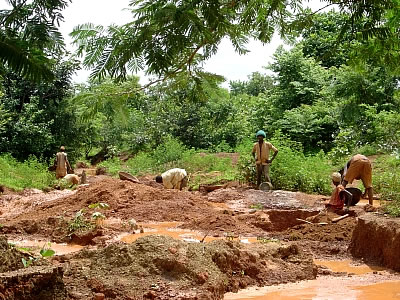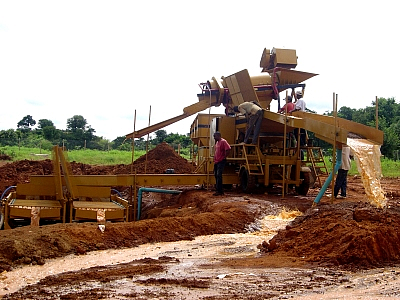





 |
|
mining and processing of gold
Taking the good from the bad
Ore samples are taken and examined for the metallurgical quality of the gold
in order to determine the appropriate processing technique required to remove
the gold. The mine site infrastructure includes a processing area where the
ore is crushed and undergoes various processes depending on the nature of the
associated minerals and then the loose rock is sent to the appropriate
processing location. The process for low-grade ore is relatively simple: a
cyanide solution is applied to the heap, dissolving the gold, which is then
collected. High-grade ore, on the other hand, heads to the grinding mill for
a more extensive process. There are several different ore types which require
different processes for optimal recovery of the gold, for example:
 |
| |
The Old Method - Local artisan miners at
work |
|
Oxide ore goes directly to the leaching circuit, where cyanide dissolves the
gold. Refractory ore, which contains carbon, is roasted at 1000 degrees
Fahrenheit, burning off the sulfide and carbon, then heads to the leaching
circuit. Sulfide refractory ore, which does not contain carbon, is oxidized
in an autoclave in order to separate the sulfide from the ore, which then
enters the leaching circuit. In the leaching circuit, the gold is extracted
out of the solution onto activated carbon, from which the gold is then
chemically stripped. The impure gold is then melted into Dore bars, which are
about 90 percent pure gold. These bars are usually shipped to the Mint or a
refinery where they undergo further processing.
Refining: From 90 percent to 99.99 percent pure
The refining process strips out the remaining impurities from the gold, which
is either recycled scrap being upgraded or gold destined to become bullion
bars. In the first step, crude gold is melted and treated with chloride,
converting remaining metals to chlorides that will drift off the gold. The
resulting 99.5 percent pure gold is cast into electrodes known as anodes,
which are put into an electrolytic cell and passed with a current. The end
product: 99.99 percent pure gold.
 |
| |
The New Method - Mechanized Gold Mining
Process in action |
|
Reclamation: Giving back the land
After a number of years, the gold reserves in a mine will be exhausted. In
the old days, a spent mine would be boarded up and abandoned; but nowadays a
reclamation project returns the land, as much as possible, to its previous
natural state. The project follows the plan submitted to government
authorities before the mine was built, which allows the mining company to
follow strict guidelines for protecting wildlife and the surrounding
environment during the life of the mine. The reclamation project will include
such things as planting trees and grass, and returning wildlife to the area.
About Gold
Production ::
How Gold Is Used
::
How Gold Is Produced
|
|
 |





